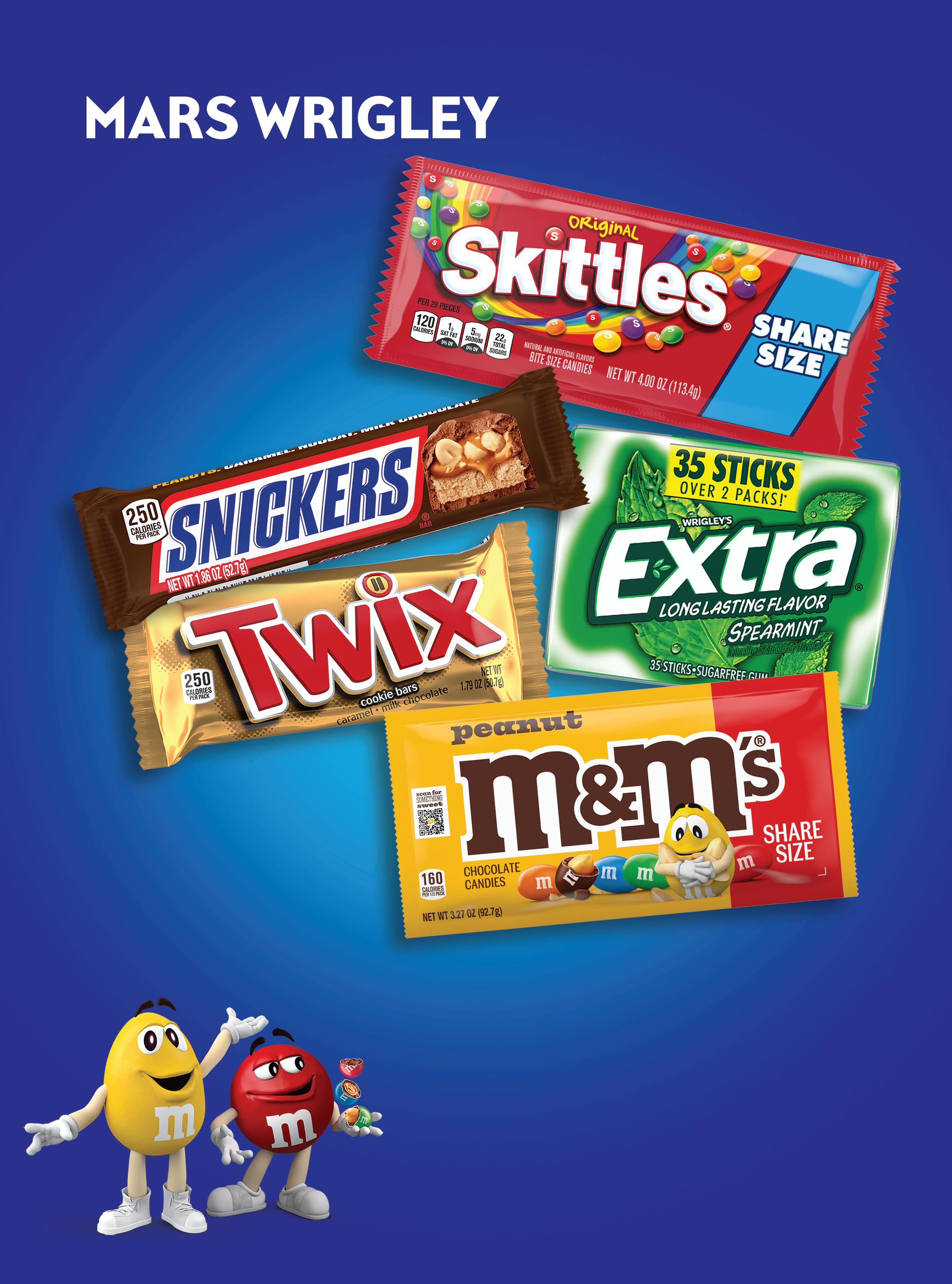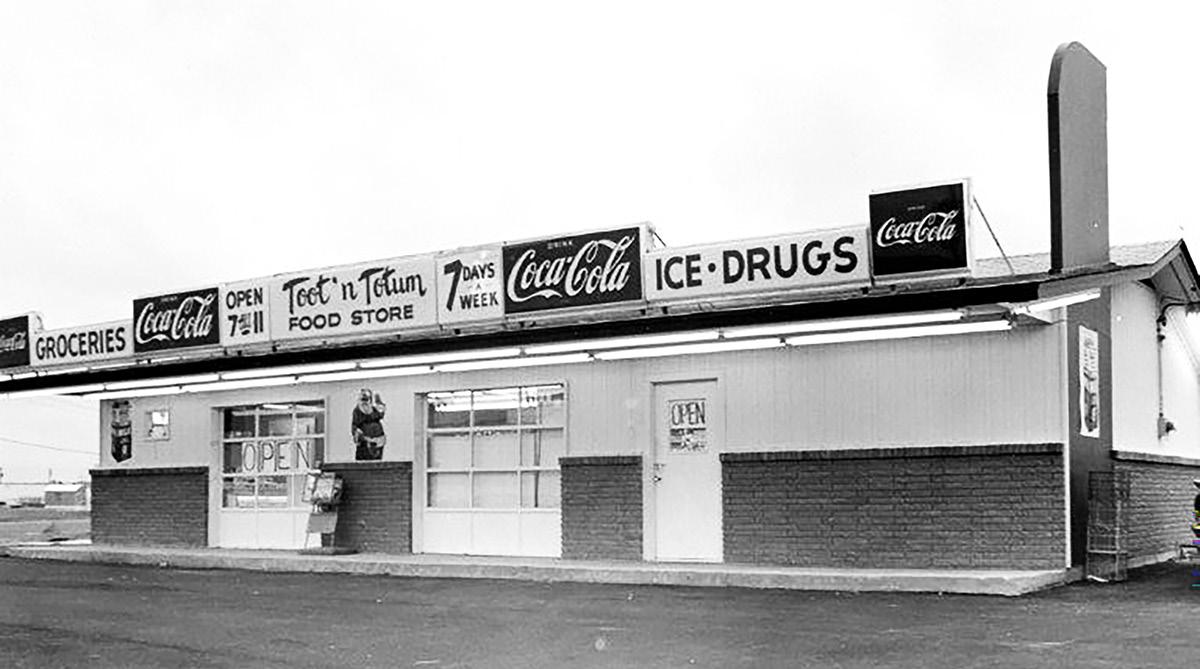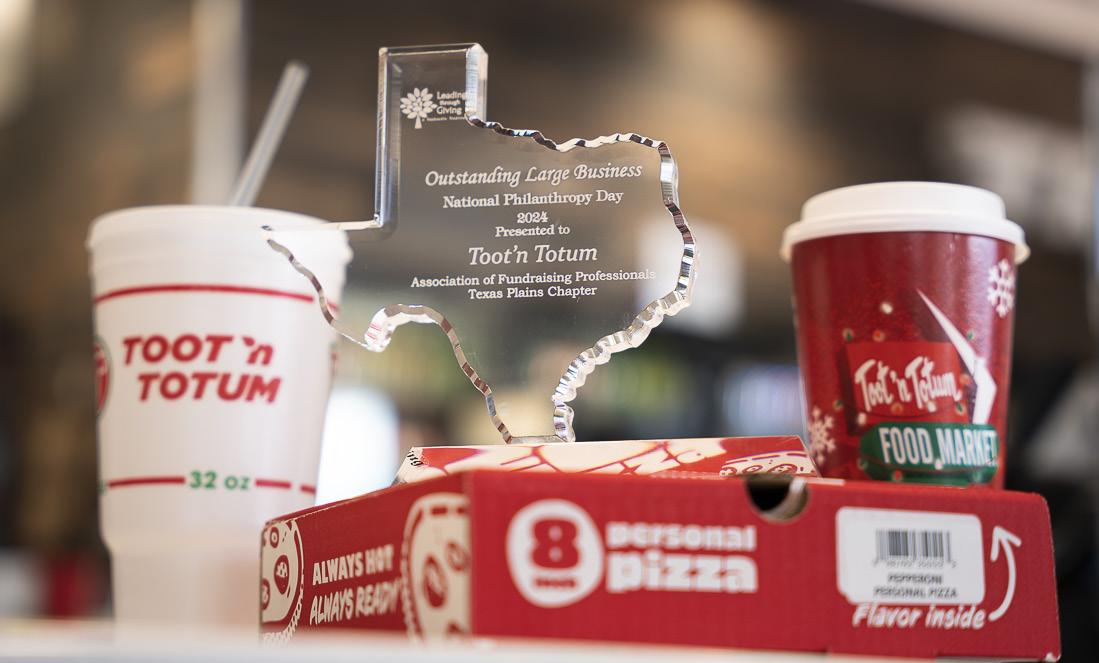

TOOT’N TOTUM TURNS 75

CStoreDecision












Navigating the Road Ahead
Get an inside look at ‘The Evolve Experience’ A mobile classroom built to help C-Stores develop forward-thinking refrigeration strategies


Decisions®
Solutions for Convenience Retailers










We’re so






















much more than just ketchup.




Red Gold® is here to make your customers’ saucing experience easy and enjoyable with a variety of dunk cup options such as: ketchup, marinara, BBQ, and seafood cocktail sauces. The dunk cups are a convenient way to enjoy on-the-go, delicious sauces with menu items such as fries, burgers, chicken tenders, shrimp, and so much more!
Scan to request a free sample kit!



































request a free sample kit!







the CSD Group
CStoreDecisions CStoreDecisions com CStoreDecisions






Leading Through Innovation
EDITORIAL
VP EDITORIAL, FOOD, RETAIL & HOSPITALITY Danny Klein dklein@wtwhmedia.com
EDITOR-IN-CHIEF Erin Del Conte edelconte@wtwhmedia.com
SENIOR EDITOR Emily Boes eboes@wtwhmedia.com
ASSOCIATE EDITOR Kevin McIntyre kmcintyre@wtwhmedia.com
COLUMNIST David Spross
EDITOR EMERITUS John Lofstock
CREATIVE SERVICES
VICE PRESIDENT, CREATIVE DIRECTOR Matthew Claney mclaney@wtwhmedia.com
CREATIVE DIRECTOR Erin Canetta ecanetta@wtwhmedia.com
DIRECTOR, AUDIENCE DEVELOPMENT Bruce Sprague bsprague@wtwhmedia.com
EVENTS
VP, ASSOCIATION & COMMUNITY ENGAGEMENT Allison Dean adean@wtwhmedia.com
DIRECTOR OF EVENTS Jen Osborne josborne@wtwhmedia.com
EVENTS MANAGER Brittany Belko bbelko@wtwhmedia.com
EVENTS MANAGER Jeannette Jelks jjelks@wtwhmedia.com
EVENTS COMMUNICATIONS COORDINATOR Emma Paul epaul@wtwhmedia.com
WTWH MEDIA, LLC 1111
Ph: 888-543-2447



SUBSCRIPTION INQUIRIES
SALES TEAM
VP SALES, FOOD, RETAIL & HOSPITALITY Lindsay Buck lbuck@wtwhmedia.com (774) 871-0067
KEY ACCOUNT MANAGER John Petersen jpetersen@wtwhmedia.com (216) 346-8790
SALES DIRECTOR Tony Bolla tbolla@wtwhmedia.com (773) 859-1107
SALES DIRECTOR Patrick McIntyre pmcintyre@wtwhmedia.com (216) 372-8112
SALES MANAGER Simran Toor stoor@wtwhmedia.com (770) 317-4640
MARKETING MANAGER Jane Cooper jcooper@wtwhmedia.com
CUSTOMER SERVICE REPRESENTATIVE Annie Paoletta apaoletta@wtwhmedia.com
CONTENT STUDIO VP, CONTENT STUDIO Peggy Carouthers pcarouthers@wtwhmedia.com
WRITER, CONTENT STUDIO Ya’el McLoud ymcloud@wtwhmedia.com
WRITER, CONTENT STUDIO Abby Winterburn awinterburn@wtwhmedia.com
LEADERSHIP CEO Scott McCafferty smccafferty@wtwhmedia.com


To manage current print subscription or for a new subscription: https://cstoredecisions.com/cstore-decisions-subscriptions/ Copyright 2025, WTWH Media, LLC

CStore Decisions is a three-time winner of the Neal Award, the American Business Press’ highest recognition of editorial excellence.
EDITORIAL ADVISORY BOARD
Nate Brazier, President and Chief Operating Officer
Stinker Stores • Boise, Idaho
Robert Buhler, President and CEO
Open Pantry Food Marts • Pleasant Prairie, Wis.
Herb Hargraves, Chief Operating Officer
Sprint Mart • Ridgeland, Miss.
Bill Kent, President and CEO
The Kent Cos. Inc. • Midland, Texas
Bill Weigel, CEO
Weigel’s Inc. • Knoxville, Tenn.
Dyson Williams, Vice President
Dandy Mini Marts. • Sayre, Pa.
NATIONAL ADVISORY GROUP (NAG) BOARD (RETAILERS)
Vernon Young (Board Chairman), President and CEO
Young Oil Co. • Piedmont, Ala.
Greg Ehrlich (Chair Elect), President
Beck Suppliers Inc. • Fremont, Ohio
Joy Almekies, Senior Director of Food Services
Global Partners • Waltham, Mass.
Jeff Carpenter, Director of Education and Training
Cliff’s Local Market • Marcy, N.Y.
Richard Cashion, Chief Operating Officer
Curby’s Express Market • Lubbock, Texas
Megan Chmura, Director of Center Store
GetGo • Pittsburgh
Ryan Faville, Director of Purchasing
Stewart’s Shops Corp. • Saratoga Springs, N.Y.
Cole Fountain, Director of Merchandise
Gate Petroleum Co. • Jacksonville, Fla.
Kalen Frese (Board Chairman), Director of Merchandising
Warrenton Oil Inc. • Warrenton, Mo.
Alex Garoutte, Director of Marketing
The Kent Cos. Inc. • Midland, Texas
Derek Gaskins, Chief Marketing Officer Yesway • Des Moines, Iowa
Joe Hamza, Chief Operating Officer Nouria Energy Corp. • Worcester, Mass.
Beth Hoffer, Vice President
Weigel’s • Powell, Tenn.
Brent Mouton, President and CEO
Hit-N-Run Food Stores • Lafayette, La.
Lenny Smith, Vice President Crosby’s • Lockport, N.Y.
Dyson Williams, Vice President
Dandy Mini Marts • Sayre, Pa.
Hussein Yatim, Vice President YATCO • Marlborough, Mass.
Supplier Members
Kyle May, Director External Relations
Reynolds Marketing Services Co. • Winston-Salem, N.C.
Todd Verhoven, Vice President of Sales
Hunt Brothers Pizza • Nashville, Tenn.
Steve Yawn, Director of Sales
McLane Company Inc. • Temple, Texas

Cut Theft, Boost Profits
Trust the hook-makers at Trion to invent creative solutions to prevent individual item theft as well as mass “sweeping” of merchandise. Easy-to-use, ScanLock® is an inexpensive key-lock system that secures most common scan hooks — and even retrofits existing hooks in place!

■ Install locks alone to retrofit your existing hooks in-store, or full lock-and-hook combinations in your choice of hook and label holder styles.
■ Secures scan hooks up to 1/4" diameter, with 1" wire spacing.
■ Secure all items or display some unlocked. Display 1 or 2 items unlocked for easy customer access while balance of stock is locked and held secure.
■ Simple swing-aside access. No need to remove the lock to access & sell items.
■ User-friendly design re-locks without a key. Open several hooks for hands-on selling to customers, replace items and re-lock in an instant without fumbling for the key.

■ Optional Security Plate secures hook to pegboard to provide additional theft deterrence.
Made in the U.S.A.















































CStoreDecisions










Editor’sMemo
Embracing a Legacy of Resilience
AS WE RING IN 2025 and the arrival of a new administration to the White House, Toot’n Totum, featured in this month’s cover story, is also celebrating its 75th anniversary. Reaching 75 years in business is no small feat, and in today’s increasingly challenging environment it’s becoming an even more difficult goal for many family-owned businesses to attain.
Reaching this milestone means that for three-quarters of a century, Toot’n Totum has adapted to changing consumer preferences, weathered economic storms and evolved its offerings to remain a vital part of the communities it serves. These adaptations reflect a larger truth: success in the convenience store industry depends on agility. Even now, Toot’n Totum isn’t resting on its laurels. The chain is investing in new-to-industry stores, growing its footprint in new operating areas, launching a new loyalty program and upgraded mobile app, and expanding its foodservice offerings. It’s also focused on investing in developing its team members to ensure it has strong leaders managing its stores and doubling down on vertical integration. Toot’n Totum knows firsthand that innovation is crucial if you wish to remain relevant for decades to come.
While milestone anniversaries within the industry offer us an opportunity to reflect on our own past successes and future goals, it also provides a moment to examine the broader challenges facing the convenience store industry as a whole in 2025. In today’s economic climate, even the most seasoned operators are feeling the strain. Rising costs, minimum wage increases and shifting consumer spending patterns due to inflation are converging to create increasing pressure on retailers. This month’s special report, “Economic Outlook: The Pathway to Profits in 2025,” notes that investing in loyalty programs, doubling down on data and carefully considering pricing strategies that add value for shoppers are critical in 2025.
Matt Riezman, partner for c-store advisory firm NexChapter, who shared his insights with me for the report, noted that customers who find they have additional spending power are likely to spend that at the places where they have the strongest relationships. Therefore, the retailers likely to see

gains are “the retailers that have been investing in building relationships with customers, investing in building loyalty, building consumer engagement — especially digital consumer engagement,” he said.
C-stores also must pay attention to changing customer preferences. The continued popularity of Dry January highlights a shift among young adult consumers toward non-alcoholic beverage preferences and an opportunity for c-store retailers, as outlined in this month’s article “Choosing Mocktails and NA Beer.” Meanwhile, the rising adoption of electric vehicles (EVs) and fluctuating fuel demand add another layer of complexity for c-stores, as outlined in this month’s article “Fuel: Adapting to Alternatives.”
INNOVATING FOR TOMORROW
As Toot’n Totum’s anniversary demonstrates, resilience is ingrained in the DNA of successful convenience store operators. Like Toot’n Totum, we see much of the industry responding to industry changes by moving toward high-quality foodservice operations. This month’s article “Foodservice Flourishes Through Simplicity” showcases how retailers can strategize for success with food in an environment of rising costs. Retailers are also investing in loyalty programs as well as leveraging data to personalize customer experiences, optimize inventory and prepare for the arrival of artificial intelligence solutions.
As we look to the future, the lessons learned in the industry over the past 75 years provide a roadmap for navigating the complexities of an industry that must constantly evolve to meet the needs of its customers and communities. There’s no doubt the industry will continue to thrive whatever changes may come, but the retailers poised to be here for the next 75 years will be the ones that embrace the shifts and work to innovate to keep pace with the demands of a rapidly changing world.



QUICKBITES
GEN Z CONSUMER INSIGHTS
Gen Z comprises a key demographic among shoppers, and as retailers learn more about their trends and habits, they can strategize to appeal to this consumer group.
ONLINE PICKUP TRENDS
According to 84.51 ° , Gen Z primarily buys online for pickup, whereas millennials, Gen Xers and baby boomers shop for groceries in-store more often. Also:
• Gen Z spends 2.6 times more per pickup trip than in-store trips.
• Millennials spend around 2.4 times more per pickup trip than in-store trips.
• Gen X spends around 2.4 times more per pickup trip than in-store trips.
• Baby boomers spend 2.2 times more per pickup trip than in-store trips.
HISPANIC POPULATION BOOMS

GEN Z BEVERAGE PURCHASES
The likelihood of purchasing a beverage varies among the different Gen Z age groups, as well as the type of beverage. According to Coca-Cola Lens:


CHOCOLATE PREFERENCES
Chocolate is a fan favorite among consumers. According to the National Confectioners Association:
• 70% of Gen Z Americans feel that chocolate belongs in a happy, balanced lifestyle.
• 71% of millennial Americans feel chocolate belongs in a happy, balanced lifestyle.
• 47% of consumers prefer their chocolate with ingredients such as caramel, peanut butter, almonds and peanuts. Caramel has the largest appeal across generations.
• Millennials are most likely to select chocolate with other flavors, while Gen Z is more likely to take their chocolate straight up.
Source: National Confectioners Association, “Getting to Know Chocolate Consumers," 2024
NUTRITIONAL PREDILECTIONS
When it comes to nutrition, the top three benefits those aged 18-34 seek are:
1. Functional Benefits 2. High Protein 3. Clean Ingredients
Source: 84.51°, “2024 Year in Review: Balancing Act: Wallet & Wellness,” Real Time Insights Survey, October 2024
Source: Circana, “Part I: Meet the U.S. Hispanic CPG Consumer,” October 2024
Coca-Cola Lens, “Who Is Gen Z?” May 2024 Source: 84.51°, “Meet the shopper of the future”


















































































































































































































































































































































































2025 Tobacco Legislative & Regulatory Outlook
NATO’s David Spross breaks down the federal, state and local predictions for tobacco legislation in 2025.
David Spross • NATO
With a new year comes a new White House administration, a new Congress and new State legislative sessions. As a result, tobacco and nicotine legislation and regulations will once again be a front and center issue.
In April 2024, the Biden administration delayed finalization of the menthol cigarette and flavored cigar bans until after the election because “the proposed rules have garnered historic attention and the public comment period yielded an immense amount of feedback, including from various elements of the civil rights and criminal justice movement,” according to a Department of Health & Human Services statement on April 26, 2024. With President-elect Donald Trump scheduled to take the oath of office in a few days and a new Food and Drug Administration (FDA) commissioner waiting to be confirmed, a likely scenario is that the proposed rule does not receive further action or is withdrawn.
It is unlikely that the Biden administration finalizes the rule prior to Inauguration Day. Even if it does, the rule will be subject to disapproval under the Congressional Review Act. Under that law, which applies to any rule issued fewer than 60 working days before the end of the administration, a resolution of disapproval can be considered by Congress and, if approved, the policy would go back to the pre-rule status.
The Trump administration announced
new leadership for both the FDA and the Centers for Disease Control and Prevention, and it’s possible these personnel changes may lead to policy changes at the Center for Tobacco Products (CTP). Other issues that CTP will focus on in 2025 include continuing to process premarket tobacco product applications (PMTAs) and prioritizing enforcement around illicit vapor products.
CONGRESSIONAL OUTLOOK
In 2024, both the U.S. Senate and House held hearings with both the commissioner of the FDA, Robert Califf, and the FDA’s CTP director, Dr. Brian King. In those hearings, Congress has been critical of the FDA as “slow,” noting it “lacked clarity” on PMTAs and needs to be “more proactive” in working with stakeholders. Congress has also expressed concerns over the proliferation of unsafe and illicit vapor products coming into the U.S. marketplace from China and the lack of enforcement to remove these products from store shelves.
Further, Congress will likely continue to pressure CTP to bring regulatory order to the vapor marketplace by finishing the PMTA review process and implementing an effective enforcement plan around illicit vapor products.
STATE PREDICTIONS
All 50 U.S. states will hold legislative sessions in 2025. As with every year,
approximately 20 states will likely consider tobacco excise tax increases with inflation affecting the economy and the termination of federal COVID assistance funds. In 2024, almost all of these proposals have failed, as only Maryland increased tobacco taxes. Additionally, some states that currently do not tax vapor products or nicotine pouches could introduce legislation levying excise taxes on those categories.
Approximately 15 states will likely consider some form of flavored tobacco product ban. With California having a statewide flavor ban, neighboring states such as Oregon and Washington have considered bills and will likely do so again in 2025. Northeastern states that surround Massachusetts, the first state to enact a flavor ban, will also likely consider proposals. In 2024, a bill to ban flavors passed the Vermont legislature but was vetoed by the governor.
Also expected to continue in 2025 is the emerging issue of creating state e-cigarette registries. The introduction of these bills is in response to the uncertainty around the FDA PMTA process and the proliferation of flavored disposable e-cigarettes that are on the market. The FDA has not completed processing applications for thousands of e-cigarettes and other nicotine products. The FDA has only approved the marketing of approximately 30 e-cigarette products, making the regulatory status unclear, to

both retailers and the public, for a large number of products, such as those for which a PMTA was never filed, those for which a PMTA was timely filed and the application is awaiting an order, and those for which a PMTA was denied but the application remains pending for legal reasons. These bills create a statebased directory that requires e-cigarette manufacturers to submit information to state tobacco regulators demonstrating that the sale of their e-cigarette products in the state complies with FDA regulations and guidance. The states that have enacted registry legislation include Alabama, Florida, Iowa, Louisiana, Kentucky, North Carolina, Oklahoma, Utah, Virginia and Wisconsin.
LOCAL EXPECTATIONS
In the past five years, local activity has increased dramatically as many major
“In the past five years, local activity has increased dramatically as many major cities have implemented tobacco flavor bans.”
cities have implemented tobacco flavor bans. Two major cities, Denver and Kansas City, Mo., have recently considered banning flavors, and it is expected that this trend will likely continue in 2025. Additionally, the National Association of Tobacco Outlets (NATO) team is leading advocacy efforts with several Massachusetts towns opposing “nicotine-free generation” proposals that would ban the sale of tobacco and products to anyone born after a certain date.
In 2025, NATO is committed to remaining engaged in these and other
issues and at all levels of government to help protect its retail members and inform legislators of the unintended consequences of these proposals. NATO is proud to serve its retail members and to communicate to legislators and regulators how its members sell tobacco products responsibly and in compliance with all laws and regulations.
David Spross is the executive director of the National Association of Tobacco Outlets (NATO), a national retail trade association that represents more than 66,000 stores throughout the country.

TOOT’n TOTUM TURNS 75
Erin Del Conte • Editor-in-Chief

With its 100th store under construction and a focus on new builds, foodservice expansion and digital upgrades, the Amarillo-based chain honors its legacy while embracing the future.
TOOT’N TOTUM IS CELEBRATING its 75th anniversary with impressive momentum, driving growth through newto-industry (NTI) builds, particularly in the Lubbock, Texas, area. Headquartered in Amarillo, Texas, the chain continues to strengthen its competitive edge by embracing vertical integration, expanding its foodservice offerings, and unveiling a revamped mobile app alongside an upgraded loyalty program.
It currently operates 99 stores in Texas, Oklahoma, Kansas and New Mexico,
and its 100th store is currently under construction just down the street from its main headquarters and scheduled to open in August 2025.
Reaching the chain’s milestone 75th anniversary and 100th site is “really exciting,” said Andrew Mitchell, CEO and president of Toot’n Totum and a thirdgeneration member of the family business that was founded by his grandparents.
“I think what my grandmother would really appreciate the most is the team that we’ve developed to carry on this
generation of the family business and to continue the pace of our growth strategy,” Mitchell said. “Seventy-five years in business is a long time. We’re excited about the future as well.”
As it builds on three-quarters of a century in business, the company remains deeply committed to the mission and values that have fueled its success throughout its history. Those values include honor and value; being team focused and guest ready; taking ownership; and providing a quick, clean and
convenient experience.
“Our mission is to create experiences worth repeating for each and every guest and vendor partner we encounter on a day-to-day basis,” Mitchell said.
BUILDING TOOT’N TOTUM
Toot’n Totum got its start in 1950 when Mitchell’s grandparents, Eldon “Lefty” Mitchell and his wife Novie, opened their first c-store on 15th and Washington in Amarillo, Texas. As they grew the chain to six stores over the next five years, they


simultaneously ran the utility company Mitchell Electric and the gift shop business Little Brown House. When Lefty passed away in 1955, Novie took the reins. Her entrepreneurial spirit and unwavering work ethic laid the foundation that shaped Toot’n Totum into the success it is today.
“At that time, she had two children,” Mitchell explained. “She had lost her husband and was running all of these businesses. She narrowed her focus down to Toot’n Totum, and that’s where she put all of her efforts.”
The efforts paid off. By 1988, the chain had grown to 50 c-stores in Amarillo.
In 1996, Novie’s son, Greg Mitchell, as president and CEO, and his wife Julie began to steer the chain’s expansion across the Texas Panhandle via acquisitions. Through their leadership the company began to prioritize vertical integration, expanded into the lube shop and car wash business, and moved into new operating areas, including Kansas and Oklahoma in 2015 and New Mexico in 2020. Today, Greg serves as chairman.


Andrew Mitchell, Greg’s son, stepped into the CEO role in 2023. His brother Jeff Mitchell acts as VP of construction.
“Jeff handles the day-to-day operations with our general contractors, and he also runs our family ranch,” Mitchell said. “I’ve also got two incredible sisters that are not in the business on the day-to-day side but are very involved in aspects of the company. There are 14 grandchildren, and we hope someday one or two of them — or who knows, all of them — might want to be involved with the company.”
Mitchell shared that leading the company as the third generation in a family business is both an exciting honor and a daunting responsibility, but he also added that the company’s success is a true team effort.
“We do everything collectively as a group. The team we’ve developed … they’re absolutely critical, from our employees, our human resources (department), all the way to our operations, our marketing, our fuel, our category managers — everything about our company is all based around our team,” he said.
VERTICALLY INTEGRATED
One key to Toot’n Totum’s success has been its focus on vertical integration.
“We’ve really taken the ability to
vertically integrate as far as we possibly can,” Mitchell said.
Around 15 years ago, the convenience store chain began handling its own warehouse distribution. Today, it distributes supplies and retail items to its chain of stores once or twice a week depending on the location.
In the forecourt Toot’n Totum features its own proprietary brand of Toot’n Totum gas, in addition to partnering with Valero and Phillips 66. Six years ago, the company began using a transportation affiliate called SUPA Inc., which handles about 90% of the chain’s fuel transportation to its sites, including diesel exhaust fluid deliveries.
The c-store chain has a centralized kitchen located about three miles from the company headquarters that acts as a commissary where the chain produces its fresh products daily and delivers them warm or cold throughout the day to neighboring locations.
Toot’n Totum also runs 10 Express car washes — 90-120-foot tunnel washes that feature unlimited car wash subscriptions — and nine Car Care Center lube centers, some of which are co-located adjacent to the c-stores.
The company also operates a sign division called Sign Pros, which handles all signage installations on new builds, as
Novie Mitchell, who founded Toot’n Totum alongside her husband Eldon “Lefty” Mitchell, laid the foundation that shaped Toot’n Totum into the success it is today.
well as maintenance on signs throughout the company; a landscaping business called Lawn Pros, which takes care of all of the grass, tree and landscaping needs at its many locations; and a cleaning business called Cleaning Pros, which keeps the sites squeaky clean with power washes on lots, deep scrubs and parking lot cleanup.
“So basically, everything from curbto-curb and door-to-door we’re trying to do in-house with our own teams at our own time, so we can try and not inconvenience the guests as much as possible,” Mitchell said. “We have an internal quote … ‘Nobody takes care of Toot’n Totum like Toot’n Totum.’”

(Left) Chairman Greg Mitchell was instrumental in steering Toot’n Totum’s expansion across the Texas Panhandle during his time as CEO. His son Andrew Mitchell (right) took the reins as CEO in 2023.
















STATE-OF-THE-ART DESIGN
Toot’n Totum has been rapidly expanding in the Lubbock, Texas, area, opening 10 NTI stores there over the past two years, along with an additional NTI location in Lamesa, Texas.
After it opens its 100th store this fall, the chain is set to debut another NTI site in Lubbock.
Its NTI stores feature a Gen-3 look, which includes wooden accents and textures, a red-and-white color scheme, open ceilings with cloud-based lighting and stained concrete floors. The stores offer a clean and inviting atmosphere with colorful graphics and logos above the various sections of the store. The chain is also enhancing lighting in its bathrooms and adding tile to create a more vibrant atmosphere.
“We changed that whole dynamic,” Mitchell said.
The store layout shifted as well to provide more space for an expanded grab-and-go food section and a larger checkout area to enhance its drivethrough operations.
Drive-through has been a big focus for Toot’n Totum.
“We started off small in the drivethrough industry … and then we really stepped it up in every single store we built,” Mitchell said.
At first it just allocated space for a window, but over time it expanded to adding speaker boxes so guests can preorder before they get to the window as

well as seamless payment options.
“We started seeing increased traffic, but we also started to see that convenience wins,” Mitchell said.
The drive-through concept ties into Toot’n Totum’s values of quick, clean and convenient. Guests can order anything from the drive-through except for refills, lottery, prepaid fuel or money orders.
The stores Toot’n Totum is building today are between 5,200 square feet to 6,700 square feet, which includes space for a drive-through. The chain also operates 16 travel centers that span 7,600 square feet and feature high-speed diesel and trucker amenities.
Three of its newer locations feature electric vehicle charging through an agreement with Tesla. One of the sites

includes 12 superchargers and two others have six per site.
Toot’n Totum is also committed to refreshing its legacy locations. In 2024 it completed four remodels, and it has another six on the docket for 2025. As the chain remodels sites, it’s upgrading all lighting to LED while revamping store interiors to put more emphasis on the food offerings. At most legacy sites, the chain displays grab-and-go food in a walkaround center island. As these stores are remodeled, they’re receiving a food display cooler that is flush with the wall, ensuring all products are faced in front of the guest so they can better observe the selections at once. It’s also moving the grab-and-go section closer to the overall food area and fountain dispensers.
FAST ‘N FRESH FOOD
Toot’n Totum makes the majority of its fresh grab-and-go foods at its commissary kitchen and delivers the items to its chain of stores under the fast ‘n fresh brand. That includes items like freshmade sandwiches, salads, burritos and subs, parfaits and breakfast burritos.
“Our menu is diverse. We’ve got an entire division set up for our food, and the kitchen is where it all starts,” Mitchell noted. “We’re trying to give guests an opportunity for a sandwich like no other, and it is absolutely the freshest we can possibly bring to our sites,” Mitchell noted.
Through the kitchen it also developed three proprietary programs: Mitch’s Texas
Toot’n Totum’s stores have come a long way since 1950. Below is an image of a vintage Toot’n Totum.
Toot’n Totum runs 10 Express car washes, which are 90-120-foot tunnel washes that feature unlimited car wash subscriptions.

Toot’n Totum was recognized at the Association of Fundraising Professionals Texas Plains Chapter’s annual National Philanthropy Day event as the Outstanding Large Business for Philanthropy in the Texas Panhandle. Pictured right, the award sits atop a box of Red’s Pizza — one of the chain’s foodservice offerings.
Style BBQ, Red’s Pizza and Oasis Tea.
Seven stores feature the Mitch’s Texas Style BBQ program, while 64 sites offer its newest concept, Red’s Pizza, which launched in 2024 and includes a number of limited-time offers.
Most recently Red’s Pizza partnered with Texas Tech football, whose colors are red and black, and created a red-andblack pizza using black olives and pepperoni on a honey crust called “Game Day Pizza.” Toot’n Totum is the official c-store partner of Texas Tech Athletics.
During Halloween it debuted an “Inferno” Pizza — a pepperoni pizza with a ghost pepper sauce drizzled on top.
“It was a very, very hot pizza,” Mitchell said. As part of the festivities, it also converted one of its car wash tunnels into a haunted house.
At press time, the chain was featuring

a dessert pizza that resembled an apple pie, with fresh apple slices, cinnamon and sugar on a warm crust.
A strong food program includes an ample beverage selection, so Toot’n Totum launched the Oasis Tea program, which is a fresh-brewed tea offering.
“We’re purifying the water to a high purification (level),” Mitchell said. The program is available at three sites, and the chain plans to begin expanding it to as many locations as possible.
High-quality coffee is also a priority. Select stores with above average coffee sales are implementing bean-to-cup

coffee machines. Mitchell estimated that about 75% of the stores have implemented bean-to-cup.
“We give that opportunity for a guest to have the soft heat or the bean-tocup throughout the day. We’ve really enjoyed bean-to-cup. It does help us in making sure that we have a quality product each and every time for our guests,” Mitchell said.
Toot’n Totum is also leveraging branded partnerships on the food front. It partnered with Amarillo brand Donut Stop to learn how to make fresh-made doughnuts and now makes them each morning in its kitchen and delivers them daily to about 20 Texas locations, which serve them fresh in-store.
In addition, it operates two Which Wich Superior Sandwiches shops and 10 Wendy’s locations, some of which are standalone while others are located inside of the chain’s travel center locations.
As it continues to move in a food-forward direction, Toot’n Totum is placing an emphasis on grab-and-go.
“We know our guests are busy, and we know they want something quick and convenient, and so we try and strive for that each and every day with the quality of our product and the investment and time that we’re putting into it,” Mitchell said.
In 2023, Toot’n Totum introduced an order-ahead and delivery platform called FetchUm, which its marketing department created in partnership with Vroom. Guests can order online and pick up their
Toot’n Totum recently celebrated the opening of its 10th Lubbock, Texas, location.


Toot’n Totum Timeline
First Toot’n Totum store
Six Amarillo locations
50 Amarillo locations
Toot’n Totum purchased select Diamond Shamrock stores
Toot’n Totum opened first Car Care Center
Toot’n Totum purchased select Phillips 66 stores, including one location in Borger, Texas
Cleaning Pros established
Purchased Frontier Fuels Convenience Stores in Dalhart, Texas
Expanded to Kansas and Oklahoma
Opened first Which Wich Superior Sandwiches
Opened first Wendy’s restaurant
Expanded to New Mexico and partnered with Donut Stop
Opened flagship travel center at I-40 & Lakeside
Expanded to Lubbock and Lamesa
Established FetchUm pickup & delivery platform
Launched Red’s Pizza; Opened 10th store in Lubbock
75th anniversary celebration and 100th convenience store grand opening
orders via the drive-through for added convenience or opt for delivery via Vroom and Uber.
LEVERAGING TECHNOLOGY
At press time, Toot’n Totum was in the process of reinvigorating its mobile app, which is set to launch this January, in partnership with Rovertown. The new app will feature the chain’s updated Toot’n Totum Rewards loyalty program and will bring all aspects of the business together under one platform. Customers will be able to use the app to schedule an oil change at the Car Care lube center or take advantage of an Express car wash deal. The FetchUm order-ahead and delivery program will also be integrated into the app.
“The biggest thing is the loyalty piece that we’re able to provide to our guests to earn points and use those points in the way that they see fit,” Mitchell noted.
The updated loyalty program will feature tiers. Customers will qualify for a tier based on their visit frequency. Within each tier, customers can redeem points for items such as free products or fuel discounts. Guests can also use their mobile phone number at the pump or inside the store to access their loyalty deals.
The refreshed rewards program, timed with the chain’s 75th anniversary, represents a major leap forward for the chain.
“Our first loyalty program was just a step, and it was just basically cents off on fuel,” Mitchell said. “Now we’re taking this to a whole different level.”
While the loyalty program will be exclusive to the convenience stores at first, Mitchell has his sights set on growing the program to where guests can eventually redeem points at the car washes and lube centers as well.
Toot’n Totum is also closely monitoring technological advancements and testing innovative solutions that align with its objectives. Currently, it’s piloting selfcheckout at two locations but is finding that its customer base prefers encounters with team members behind the register. It’s also evaluating opportunities with artificial intelligence (AI).
“AI is one area where we’re investing some time and effort,” Mitchell said.
Recently, the chain has been piloting










an advanced camera system powered by AI at one of its locations. Additionally, it is partnering with a company specializing in location analytics and foot traffic data to enable data-driven insights into customer behavior, site selection and market trends. The chain is also prioritizing in-store data analysis, equipping store managers with detailed, actionable metrics to enhance daily operations and decision making.
FUTURE VISION
Looking ahead, Toot’n Totum plans to continue its expansion into the Lubbock market. An additional six NTI stores are slated for development there in 2025 and 2026. The chain is now investigating other territories within its current operating footprint to earmark for expansion. But as Toot’n Totum prioritizes NTI growth, it hasn’t ruled out other modes of expansion.
“We always are looking for a possible acquisition,” Mitchell said.

Totum is also focused on internal growth through team development. Its human resources department has introduced a leadership academy called LEAD, which stands for lead, engage, act and develop. Every manager and select assistant managers go through the program, which includes a handful of full-day sessions over three months.
“We’re always trying to develop our leaders into becoming the best they can possibly be,” Mitchell said.
He added that strong store managers

can play a big role in reducing turnover and driving the overall sales of a store.
“We really want to make sure that our managers and general managers of our sites have as much leadership training as they can in their portfolio to use in their stores, to grow the business and to foster a positive honor-and-value approach to each one of our team members,” Mitchell said. “Our team members are really the ones that make Toot’n Totum move.”
The chain also continues to grow its involvement and philanthropic efforts within the communities it serves.
In November 2024, Toot’n Totum was recognized at the Association of Fundraising Professionals Texas Plains Chapter’s annual National Philanthropy Day event as the Outstanding Large Business for Philanthropy in the Texas Panhandle. While the company has received numerous accolades over the years, this one held particular significance for Mitchell.
“I am honored on behalf of our team that we’re able to do this — to give either the funds, the time or the effort to raise money for these philanthropies. This has been an incredibly special award, and we’re very honored,” he said.
As he looks to the long-term future of Toot’n Totum, Mitchell embraces a straightforward philosophy to help guide the company forward in alignment with its values: “We’re here to grow our team members and to grow our communities. We’ll continue to work each and every day to do that.” CSD
Toot’n
Toot’n Totum is investing in team development and helping its leaders become the best they can be. Its team members “are the ones that make Toot’n Totum move,” CEO Andrew Mitchell said.
Toot’n Totum’s mascots celebrate its most recent grand opening.



ECONOMIC OUTLOOK: The Pathway to Profits in 2025
By leveraging data-driven strategies and adapting to economic shifts, retailers can position themselves for growth amid heightened competition, escalating costs and industry consolidation.
Erin Del Conte • Editor-in-Chief

AS WE RING IN 2025, the convenience store industry faces a dynamic economic landscape shaped by shifting consumer preferences, ongoing consolidation, inflationary pressures and labor management challenges. While retailers are cautiously optimistic about the year ahead, they remain acutely aware of the pressures weighing on both customers’ pocketbooks and their own bottom lines.
Mario Spina, owner and CEO of The PRIDE Stores, which operates 17 locations (16 in Illinois and one in Indiana), acknowledged that the current environment — marked by rising wages, inflated fuel costs and a shrinking pool of drivers — has been challenging. Nevertheless, he is feeling positive about 2025.
“Hopefully, there will be a strong push toward reducing regulations, which will make operations easier, a reduction in the tax rate putting more money in consumers’ pockets and (allowing) the oil industry to provide more product to the
market, which should reduce the cost of fuel,” Spina said.
Tom Bachrodt, general manager of HJB Convenience Corp., which operates seven Russell’s Convenience and Russell’s Xpress locations across Colorado, Michigan, California and Hawaii, is considering the potential impacts of a second Trump presidency.
“Given the change in administration, it leaves many questions about regulations, wages, health care costs and whether the Credit Card Competition Act will pass, lowering our costs,” Bachrodt said.
Peter Rasmussen, CEO and founder of Convenience & Energy Advisors, anticipates that 2025 will be shaped by a blend of economic recovery, inflationary pressures and new policy dynamics.
“While inflation may stabilize compared to the extreme levels of 20222023, there is a strong likelihood that prices will remain elevated along with costs — particularly labor, creating
ongoing challenges for our industry,” Rasmussen explained. “C-store retailers should prepare for a continued need to adapt quickly to both macroeconomic shifts and any new federal or statelevel regulations that could emerge in response to changing political and social landscapes. Specific actionable areas include loyalty, labor-saving technologies, private label (trade down) and premium (trade up) opportunities.”
INFLATION BY THE NUMBERS
At press time, data hinted that inflation might be turning a corner.
The Consumer Price Index (CPI) rose 2.6% for the most recent 12 months ending in October 2024, a 0.2% increase from September, aligning with expectations. Excluding food and energy, the core CPI ticked up 0.3% in October and was up 3.3% over the past year. Notably, the energy index fell 4.9% over the same period, while the food index rose by 2.1%.

Despite ongoing inflation, consumer spending climbed in October. According to the Small Business Index, small business sales grew 7.1% year over year, with total transactions up 8.8% for the 52 weeks ending in October 2024. This data, derived from in-store and online point-of-sale transactions across 2 million U.S. small businesses, revealed strong monthly gains as well. October sales increased 3.7%, while transactions rose 3% compared to September.
The index increased by six points to 147, one of the largest monthly gains and the highest seen since the baseline period of January 2019.
Retail, in particular, experienced robust growth. Year-over-year sales climbed 5.8% with transactions up 9.2%. The fastest growing categories included general merchandise (up 11.4%) and food and beverage (up 8.4%). Restaurant sales also saw a 5.9% increase, accompanied by a 7.6% bump in foot traffic.
Given that this latest batch of CPI data is showing that inflation is stabilizing it’s “really pointing in a positive direction for retail,” noted Matt Riezman, partner, NexChapter, a c-store advisory firm. “The other thing we’re seeing is consumer confidence continues to grow. Consumer confidence in October was at the highest it’s been since (March) 2021, according to The Conference Board.”
Adding to the optimism, The Conference Board’s Consumer Confidence Index showed the perceived likelihood of a U.S. recession over the next 12 months


fell to its lowest level in November since the question was first added in July 2022.
While these indicators suggest a brighter outlook for 2025, experts warned that the benefits are unlikely to be evenly distributed both in terms of which customers feel relief and which retailers reap the benefits.
“Higher-income consumers may continue to spend freely, but the middle and lower-income segments will likely be more discerning in their spending, favoring essentials over discretionary goods,” Rasmussen said.
He pointed to an earnings report from Target posted in November that highlighted the trend. “(Target is) busting at the seams in excess inventory on discretionary hard goods, while their grocery division is performing well.”
Customers who find they have additional spending power are likely to spend that at the places where they have the strongest relationships, Riezman explained. Therefore, the retailers likely to see gains are “the retailers that have been investing in building relationships with customers, investing in building loyalty, building consumer engagement — especially digital consumer engagement,” Riezman noted.
That makes it critical for retailers to have a strategy for investing in loyalty and driving repeat purchases.
Still, even as inflation slows, costs remain high, and most shoppers and
retailers aren’t feeling these economic improvements in their day-to-day lives.
Mike Wilson, chief operating officer of Cubby’s Inc., which operates 39 c-stores in Nebraska, Iowa and South Dakota, emphasized the disconnect.
“Since the end of the pandemic, the cost of goods sold rose significantly, and over the last two years, our labor costs have almost doubled,” Wilson noted. “Throughout 2024, customers have been very value focused. Once consumers became reluctant to see further price increases, it started to eat away at margin.”
Raymond Huff, president of HJB Convenience Corp., echoed this sentiment. He observed in November 2024 that sales had been slowing over the past two months and, in some cases, were down compared to the previous year. “We have not experienced a softening of sales in several years,” Huff said.
SHOPPERS SHIFT SPENDING HABITS
“People are moving to less expensive items like lunch sandwiches or smaller soda sizes,” Bachrodt added, expressing concern about how the cost of living — particularly the rising cost of groceries — might impact customer spending going forward.
Huff shared his own experience with escalating prices, recalling a visit to his local grocery store, where he was shocked to see 18 eggs priced at $18. This stark example underscores why
Matt Riezman partner, NexChapter, noted signs that inflation is stabilizing is positive for retailers and that consumer confidence is growing.





Menu’s New Favorite


The #1 fastest growing snack is now available for your menu! ¡Hola! Churros™ are a delicious, easy-to-prep choice that adds creativity to your menu with all the versatility and customization you look for in delectable desserts. Wondering what you could create with ¡Hola! Churros?
Scan the QR code or visit our website at Churros.com/Ideas to find out!





customer perceptions of the economy remain bleak.
Riezman pointed to another key trend: “The cost of food away from home … has continued to increase, while the cost of eating at home has stabilized with the price of groceries.”
These dynamics are pressuring foodservice margins and intensifying competition, as quick-service restaurants (QSRs) and fast-casual chains aggressively market value. Cubby’s, which has a strong foodservice program, has faced these challenges directly. To resonate with value-conscious shoppers, the company revamped its menu messaging.
“Consumers are seeing the major
fast food giants fight over value meals on television, and even though we are significantly less expensive, they still want to perceive a value,” Wilson said. “We started offering value meals, and since then, we’ve started to see a lift in our unit sales.”
Even as the economy recovers, consumer sentiment can remain volatile, Rasmussen warned.
“Rising costs and inflation could reduce discretionary spending, leading to more cautious spending behavior,” he said. “For c-stores, the opportunity is to capitalize on key drivers — fuel, thirst and foodservice — and encourage impulse purchases to build the basket.”
RISING WAGE WOES
Attracting talent in an inflationary environment continues to pose challenges for c-store operators.
To attract applicants, Russell’s upped entry wages in 2024 and significantly raised pay for existing employees to boost retention. The labor market pressures are intensifying. Planned minimum wage hikes in Denver and California went into effect on Jan. 1. Denver’s minimum wage rose to $18.81, while California’s increased by 50 cents to $16.50. Los Angeles County already reached $17.27 in July 2024.
In Colorado, where the state minimum wage increased from $14.42 to $14.81 on Jan. 1, Russell’s is paying far
above that baseline. “We have to pay a start rate of $16.60 just to get applicants,” Bachrodt noted.
The rising costs are creating ripple effects for businesses. “I have my marketing/HR department increase prices to cover these minimum wage increases and price increases,” Huff said. “Our out (the) door cost of a candy bar and bottle of soda have become onerous. This could also be affecting sales.”
Russell’s is preparing for another round of price adjustments to maintain margins as a number of major vendors increase their prices in Q1 of 2025. It’s also elevating its high-margin snack bar items and moving its coffee program to bean-tocup to protect profitability.
However, it remains difficult to attract applicants despite competitive wages.
“Ghosting is a huge problem,” Bachrodt said. “We had two who got their first paychecks and left.”
Cubby’s has also faced escalating labor costs with average wages climbing $7-$10 per hour, per employee over the last three years.
“With the jump in minimum wages in some of the states that we operate in, we made the decision to stay significantly above minimum wage,” Wilson noted.
“Some of our major competitors have been slower to do that, and we have benefited by keeping employees and staying open.”
Ever since the end of the COVID-19
Raymond Huff, president of HJB Convenience Corp., noted rising business costs create ripple effects as businesses in turn raise prices to offset increases.

pandemic, Cubby’s has taken an aggressive approach when it comes to state rate hikes. While the Nebraska minimum wage is set to hit $15 in 2026, Cubby’s is already averaging a much higher wage in the state today.
“We believe that since we have already absorbed much of these increases over the last two years, we will be in a much better position when the laws change,” Wilson said. “Because of our decisive action regarding wages, we are not seeing the issues others are regarding hiring and retaining our staff. While there are specific stores that can be a challenge, it is no worse than pre-pandemic for us.”
Meanwhile in Illinois, The PRIDE Stores is experiencing similar pressures. Since 2019, Illinois has implemented a series of minimum wage hikes, increasing the baseline from $8 an hour to $14. The wage rose again to $15 on Jan. 1.
“This has forced PRIDE to raise wages up and down the line to stay competitive,” Spina said.
PRIDE is also contending with heightened competition from large chains expanding rapidly in its already highly competitive market area. “Fortunately, we have been able to maintain staffing throughout the company at a high level, but continuing to ensure we provide competitive wages and benefits for our staff is key,” Spina said.
To help offset the cost of wage hikes, PRIDE is identifying operational efficiencies while driving growth in other areas.

Peter Rasmussen, CEO and Founder of Convenience & Energy Advisors, predicted wage growth for entry-level positions will remain elevated in 2025 as competition for workers continues.
Looking ahead, labor challenges are expected to persist.
“The Conference Board Consumer Confidence Index in October noted 35% of consumers reported jobs as plentiful, which is a pretty high number,” Riezman noted. “That’s suggesting to me that the labor market’s tight and will continue to be tight.”
Rasmussen concurred. “The costs of staffing c-stores will remain high, and attracting and retaining quality employees may continue to be a challenge for operators,” he said. Retailers should expect wage growth for entry-level positions to remain elevated in 2025 as competition for workers continues.
The key, he said, is investing further in innovation to offset wage pressures.
“To mitigate labor costs, many convenience store operators will likely continue exploring automation solutions such as self-checkout kiosks, artificial intelligencedriven inventory replenishment and automated floor cleaning systems,” Rasmussen said. “While these technologies can reduce the strain on staffing, they also require upfront capital investment.”
Rising labor costs could also push cstores to explore the gig work economy, Rasmussen predicted. “If Uber and DoorDash can disrupt how we catch a ride, get food delivered and have products delivered in last mile delivery, then it seems an obvious next step in labor innovation is gig work in convenience retail,” he said.
NexChapter also sees convenience stores turning to technology to enable more labor efficiency and improve the experience for employees.
“These aren’t tools that are replacing people. These are tools helping people do their jobs better, but also in a way that retains them as employees,” Riezman said.
As wage pressures persist, Riezman emphasized that improving the overall employee environment and benefit pack-

age beyond the wage itself will be the key to retention.
FROM SUPPLY CHAIN TO M&A
Retailers reported that supply chain disruptions have largely subsided. While they continue in various areas or product lines, they’re more manageable than they were in recent years. However, cost increases from suppliers remain a significant hurdle.
Riezman pointed to the latest CPI data that showed transportation and warehousing expenses continue to grow. “Those are expenses that hit retailers, both directly as well as indirectly, through the cost of goods from vendors, and so there continues to be supply chain pressure that’s going to continue to put pressure on prices. … When a category is seeing increased transportation and warehouse expenses, those are going to probably start coming through to the consumer,” he said.
Riezman emphasized that it’s imperative for retailers to have pricing and promotional strategies in place as well as a clear understanding of the value they’re offering customers.
For now, c-stores are doing what they do best — adapting. PRIDE operates a large warehouse, so it has been able to bulk buy and self-distribute products, which allows it to provide a lower cost to customers. Meanwhile, Cubby’s scaled back or delayed certain projects to offset rising supplier costs.
Capital investments are being scrutinized more closely, particularly when it comes to new product lines such as beanto-cup, “to ensure a return on investment
Mario Spina, CEO, The PRIDE Stores, noted the chain has maintained staffing at a high level, and competitive wages and benefits are key.





NIC-S® is a premium, tobacco-free, nicotine brand backed by extensive scientific research, made with pharmaceutical-grade nicotine, and setting a higher standard in this OTP category.
PHARMACEUTICAL GRADE NICOTINE
GREAT FLAVORS -MINT, WINTERGREEN, ORANGE, CINNAMON, BERRY AND FLAVOR FREE
AVAILABLE IN 3MG, 6MG, AND 9MG STRENGTHS
EXTENDED NICOTINE RELEASE
LONG LASTING FLAVOR
PREMIUM SOFT POUCHES





is imminent,” Bachrodt noted. There’s also added focus on enhancing the customer experience to drive sales and foot traffic growth, Huff explained.
Despite high costs, PRIDE is committed to store growth and improvement. “To continue to be competitive your stores must be well maintained, and growth is crucial to help purchasing power plus market penetration,” Spina said.
Rasmussen cautioned that the cost of new builds and renovations is likely to rise in 2025, especially for small and independent operators, due to high construction material and labor costs.
“This is likely to slow down expansion plans for some c-store owners, especially in areas where land and real estate costs are also rising,” he explained. He added that potential labor shortages, influenced by a possible increase in deportations under the new administration, could exacerbate these challenges. As a result, he predicted an increase in merger and acquisition (M&A) activity, accompanied by decreased development of new-toindustry stores.
Also driving M&A will be the continued need for operational efficiencies, higher capital expenditures and economies of scale, Rasmussen noted. He expects large chains to pursue acquisitions of smaller regional chains to expand their footprint and market share, while smaller operators may choose to sell due to escalating costs, labor challenges or generational ownership transitions.
“The c-store industry’s M&A activity will also be influenced by private equity firms looking to capitalize on growth in convenience retailing, and today there is more private equity chasing deals than there are deals on the market,” Rasmussen said. “Add to that, upstream consolidation from our suppliers makes it incredibly hard for a smaller chain to compete with larger chains who can command better economies of scale and bulk pricing breaks.”
To stay competitive amid accelerating consolidation, c-stores must invest in technological innovation, targeted marketing with a focus on personalization, reaching customers via media channels, etc. to remain competitive, Riezman
Tracking Consumer Confidence
The Conference Board Consumer Confidence Index increased in November 2024 to 111.7, up 2.1 points from 109.6 in October 2024. The Present Situation Index, which is based on consumers' assessment of current business and labor market conditions, ticked up 4.8 points to 140.9. The Expectations Index, which is based on consumers' short-term outlook for income, business and labor market conditions — inched up 0.4 points to 92.3. When the expectations index falls below 80 it indicates a potential recession.
• 23.5% of consumers expected business conditions to improve, up from 21.1% in October.
• 15.2% expected business conditions to worsen, up from 13%.
• 19% of consumers expected their incomes to increase, down from 19.5% in October.
• 11.8% expected their incomes to decrease, unchanged from October.
pointed out. “We see lots of examples in the industry of smaller operators who are making smart investments in the right places so that they can keep up and maintain a differentiated experience, a differentiated brand, and they’re winning even against the bigger players.”
As consolidation continues, the pressure on small operators to maintain that differentiated experience will only increase, he added. Amid heightened competition, retailers are expected to ramp up their investment in technology to stay ahead.
“The retailers that are making the right investments at the right time we see coming out ahead,” Riezman said.
PRICING STRATEGIES FOR SUCCESS
Given the combination of rising costs and growing customer price sensitivity, convenience stores will need to get creative with pricing to woo customers to open their wallets in 2025. Rasmussen pointed to value-based pricing as one potential approach.
“Emphasizing value through strategic pricing, bundle offers and promotions will help attract more cost-conscious consumers,” he noted.
But it’s important that retailers pay attention to the data.
“Buy/Get performs better than twofors, as an example — so don’t just discount, but discount with the highest possible take rate,” he said.
Retailers can also take a trade up/ trade down approach. In other words, provide a mix of premium and value options across categories, allowing retailers to cater to a broader customer base.
“Price tiers help balance the need for higher margins on premium items, while still appealing to more budget-conscious customers,” Rasmussen explained. “Just the same, a consumer may purchase value and premium together, as we all enjoy attainable luxury.”
But it’s important not to discount everything, Rasmussen warned. “Don’t discount products and categories that will command full retail despite your pricing strategy,” he said.
Whatever pricing strategy c-stores choose, retailers should ensure it is data driven, category specific and that they balance margin with value, Riezman said.
With access to more data than ever, retailers can leverage these insights to deliver value, protect margins and understand a category’s role in the customer journey — whether it serves as an impulse buy or a trip driver — while integrating these factors into their pricing strategies.
While price volatility is expected to persist through 2025, Riezman noted the silver lining is that c-stores have the tools to navigate these challenges by leveraging data effectively, establishing strong strategies and staying committed to them in the year ahead. CSD
Foodservice Flourishes Through Simplicity

As c-store retailers emphasize foodservice, many are finding simple and well-thought-out menus enhance the guest experience.
Kevin McIntyre • Associate Editor
CONVENIENCE STORE FOODSERVICE has undergone quite the journey in recent years, expanding from quick and convenient options to more robust menus with high-quality items and greater variety as c-stores have embraced food programs as a key differentiator.
Today, c-stores are giving quickservice restaurants (QSRs) a run for their
money by leveraging restaurant-quality food and beverage options with unparalleled convenience.
This emphasis on food quality has taken the industry by storm — many retailers have even opted to add professional chefs to their payrolls to ensure that what they are offering can compete and even overperform when compared to other foodservice retailers.
As a result, made-to-order has grown in convenience stores as customers have realized the value and quality that c-store operators are able to provide. Now, as customer expectations continue to shift, many retailers are working on a more streamlined approach to menu optimization while maintaining the high-quality offerings that their shoppers have come to expect.
CHOOSE


KEEP IT SIMPLE
When it comes to crafting a successful foodservice menu in 2025, simplicity is key, according to Bruce Reinstein, a partner at Kinetic12 with more than 30 years of experience in the hospitality industry.
“You have to keep it simple, but you have to be creative and provide variety,” he said.
To do this, operators need to evaluate what they are doing well, what customers are looking for and what is not necessarily performing to its full potential. From there, the answers become clear.
“If you’re selling products that are mediocre, ultimately it’s going to come back to haunt you,” continued Reinstein. “So, the beginning of simplification is to determine which products are good and can be executed consistently. If (a product can’t be), you need to really look into removing it.”
The first step retailers need to take is to look at their SKUs and ingredients — how can these be simplified and reused in other recipes to create a new experience for the customer without breaking the bank?
“You have to take the items that are quality and that you can execute well, and you have to then alter them,” noted Reinstein. “So, for instance, let’s say that
you’re in the pizza business. Take Papa Johns for example — they took their pizza, and they developed a product around the pizza that was a sandwich. So, they’re using the exact same ingredients and they’re creating some new recipes around it.”
Retailers can also leverage preprepared items that require minimal assembly on-site to help make consistency easier for foodservice employees. This can be especially helpful for retailers grappling with frequent employee changes due to high turnover.
FOODSERVICE EVOLUTION
Driving the shift to a more simplified approach to menus is the threeyear impact of record-high inflation on customer behavior, noted Tim Powell, managing principal at Foodservice IP, a management consulting firm specializing in foodservice.
Customers have become more discerning, meaning retailers may have better luck offering fewer options in a streamlined operation compared to a complex menu with more ingredients.
“Fewer choices are likely the best option for consumers, and it can also decrease waste costs for operators,” continued Powell.
Still, the decision whether or not to simplify a menu isn’t “one size fits all,” cautioned Powell. There are many different aspects to consider, as no two customers demand the exact same thing, and no two markets are identical.
“It really depends on the location, demographic and surrounding competition,” said Powell. As a rule of thumb, however, there are specific programs that tend to fare best when included on c-stores menus.
“I think if a nearby store offers burritos and chicken nuggets, it’s typically a good idea to consider those as options,” he said. “Otherwise, the curriculum should

Source: Kinetic12, “Q3 Emergence Restaurant Group Report”














include pizza, deli sandwiches, breakfast sandwiches, coffee and baked goods.”
While there’s “no silver bullet,” Powell suggested that foodservice managers “must be willing to try limited-time offers (LTOs) to see what their patrons want (as well as) what any food destinations nearby are offering.”
INNOVATION TO COMBAT INFLATION
C-store retailer Quality Dairy, which operates 27 locations in Michigan, is seeing a similar trend toward enhancing a menu with LTOs to drive excitement.
“The typical customer is spending more consciously,” said Mike Wensel, fresh food category manager for the c-store chain. “They aren’t throwing everything on the counter anymore and buying it all — they are far more calculated in their purchases.”
To adapt, Quality Dairy focuses on both simplification and innovation.
“We have our own commissary where
we produce deli sandwiches and salads either intended to be eaten hot or cold,” Wensel said. “We do put out LTOs that make sense for the season or time of year while also simplifying our menu to utilize a lot of the same ingredients to reduce SKUs.”
One of the retailer’s most popular items is the Chorizo Donut Sandwich, which leverages a sweet-heat flavor profile that is on the rise, noted Wensel.
What it really comes down to, he said, is being ready and willing to act on customer feedback to ensure the right menu items are being offered.
“Our willingness to listen to our customers and adapt to their needs (differentiates us from competitors). You should always cater to your audience — they will tell you what they want,” continued Wensel. “The love and care we put into developing our new items sets us apart from our competition.”
Today, Quality Dairy offers a range of foodservice offerings; in addition to its
freshly made deli sandwiches and salads, it features roller grill items and pizzas, among other items. A significant part of the chain’s program revolves around its catering business.
“Catering and event planning also plays a huge role in our program, as we have developed a catering arm to our foodservice that can furnish anything from a small business gathering to an old-fashioned tailgate,” added Wensel.
The company also brought on a chef to run the category — a move that has opened up the chain to a number of new partnerships and food innovations as it continues to enhance its program.
Foodservice is a flourishing category in the convenience store space, with seemingly infinite potential. Retailers that understand their customers and are refreshing their menus to allow for high-quality items and innovation while paring down the offering to keep items consistent and competitively priced are well positioned to reap the rewards. CSD









CHOOSING MOCKTAILS and NA BEER
Dry January is expected to elevate the already budding alcohol-free segment of beer, wine and spirits, and c-stores should be ready to capitalize on the trend and show customers their authority in the space.
Emily Boes • Senior Editor
IN RECENT YEARS, Dry January has become a household phrase, one which invites the general population to abstain from alcohol consumption during the month of January. Although less than half of alcohol consumers participated in 2024, the number is growing, according to CivicScience data.
Twenty-five percent of those aged 21-plus who drink alcohol reported completing Dry January, jumping past the 16% of participants who finished the challenge in 2023. Ages 21-24 showed the highest level of participation at 35%, the CivicScience survey revealed, which seems on par with various reports that suggest Gen Z is drinking less alcohol than older generations.
At convenience stores, the nonalcoholic segment saw an 18.5% boost in case sales and a 24.8% lift in dollar sales for the latest 52 weeks ending Nov. 3, 2024, according to Chicago-based market research firm Circana.
NA BEER GROWTH
Although many who decided to participate in Dry January in 2024 opted not to replace alcoholic drinks with a different option (56% per CivicScience), non-alcoholic beer is a viable choice for those who still prefer the taste or feel of drinking beer.
Of those who drink non-alcoholic substitutes regularly, 35% drink non-alcoholic beer, according to 84.51°’s recent “2024 Year in Review: Balancing Act: Wallet & Wellness” report.
At Beck Suppliers’ FriendShip c-stores, which number 31 in Ohio, non-alcoholic beer is faring well. “We increased our available selections in our top craft/ import locations considerably this past spring and increased further for the fall refreshes,” said Jarrod Demski, category manager for alcohol at FriendShip.
Demski noted the popularity of non-alcoholic beer is widespread and depends on the individual SKU.
For instance, Bud Zero and Busch NA are performing well in all FriendShip stores and have a general consumer appeal. Heineken 0.0, Guinness 0.0 and Athletic NA Brew are trending in the chain’s import- and craft-heavy locations, with popularity recently spreading to all sites.
Demski pointed to the success of a non-alcoholic beer offering that tastes close to the alcoholic version of the brand, allowing very little to be compromised. Consumers will gravitate toward this, he said.
New releases, too, are poised to increase exposure for the non-alcoholic segment. Demski predicted Michelob Ultra’s new addition to this market, as an example, will spark a non-alcoholic upward trend by up to 50% a few months after its launch.
On deciding what to stock, the vast increase in alcohol-free offerings in addition to the surge of alcoholic counterparts has made for slight difficulty, Demski said.


Store set size for each location, demographics (such as a craft-centric customer base), and the popularity of a brand on social media or in sales data influence stocking decisions.
Non-alcoholic beer is growing in popularity at EG America, as well.
“We see strong interest, especially among younger customers like millennials and Gen Z, who are often healthconscious and open to new beverage options,” said Madison Everett, senior category manager — packaged beverage & alcohol, EG America.
EG America operates 1,500 stores in
30 states under multiple banners.
The company has tested a few different non-alcoholic brands. Everett noted the category tends to see success when larger, well-known beer brands introduce a non-alcoholic option.
“These established brands seem to resonate well with customers, likely due to the familiarity and trust they’ve built,” she added.
MOCKTAIL POPULARITY
Non-alcoholic beer isn’t consumers’ only option for an alcohol-free beverage. Mocktails, for example, are long-standing

spirit replacements.
In fact, they are the most-consumed non-alcoholic beverages (that simulate the feel of a standard alcoholic drink) among those that offer low or no alcohol, with 65% of people who drink nonalcoholic options preferring mocktails, per 84.51°.
Seventeen percent of these consumers choose non-alcoholic wine, 13% pick non-alcoholic champagne and 9% want non-alcoholic tequila.
That said, not all c-store chains have a wide variety of mocktail options available. At FriendShip stores, the mocktail selection is light.
“Overall, there are not very many mocktail options in Ohio, and the one that I know of is available by a vendor we do not currently do business with due to limited store coverage,” said Demski.
Still, the beverage presents an opportunity for c-stores as new mocktail products emerge and more consumers look for alcohol alternatives.
DRY JANUARY OUTLOOK
Dry January will kickstart 2025’s alcohol-free trajectory, with many consumers foregoing alcohol at the beginning of the year and likely tapering off in February. For some, however, it may spur















Get Comfortable with the Future of Sustainable Refrigeration


The Evolve Experience stops at retailers' front door allowing them to encounter new CO2 and R-290 solutions and learn about the new technology to help them make informed decisions moving forward.









Scan here to learn more about the Evolve Experience




























NA Beer Spells Growth
Non-alcoholic beer jumped 24.8% in dollar sales and 18.5% in case sales, despite a 5.3% increase in price per case, for the 52 weeks ending Nov. 3, 2024. At a 163.2% surge in dollars and 154% rise in cases, the Corona non-alcoholic brand family saw the largest upswing in sales.
Source: Circana Total U.S. Convenience data for the 52 weeks ending Nov. 3, 2024
new interest in non-alcoholic beverages year-round.
There’s a general growth trend for the non-alcoholic segment, Demski noted, with January seeing a higher escalation.
“I have been in the industry for 29 years and have seen some brands and segments have some seasonality, but the non-alcoholic segment I feel experiences a slight ‘uptick’ in January, but even that slight spike is shadowed by the steady increases in the overall sales velocity,” he said.
He’s realized that the non-alcoholic customer is developing into a “longerterm player in this arena,” not just a weeklong or monthlong customer.
“They enjoy the taste of beer or cocktails, but they do not want to experience the side effects of the alcoholic versions or are wanting the ‘better-for-you’ options,” Demski continued.
Still, FriendShip plans to promote Dry January in its stores, intending to establish itself as a carrier of a leading non-alcoholic selection for 2025.
The stores chose not to greatly advertise Dry January in the past, but Demski believes in the sales value and impact that promoting the non-alcoholic options can produce.
EG America, too, expects to see a hike in sales during Dry January, even as nonalcoholic beer and mocktail sales have strengthened over a longer period.
“Interest in these drink options continues to grow, and then each year more people give Dry January a try. While nonalcoholic beer still makes up a relatively small portion of our total beer sales, we’re expecting to see a similar (or even bigger) boost this coming January as interest continues to build,” said Everett.
CivicScience data shows that multiple beverage types were used as alcohol replacements during Dry January 2024. While a percentage of these participants opted to consume more soda and seltzers, some turned to cannabis or cannabidiol products.
Fourteen percent of participants chose mocktails as their beverage of choice,
and 12% preferred non-alcoholic beer. Surprisingly, 5% of those who partook in Dry January drank more kombucha.
“Non-alcoholic options are here to stay and will continue to grow as consumer preferences shift. With more people prioritizing health and wellness, we’re seeing steady interest in these beverage options and expect that trend to keep growing,” Everett concluded.
Demski also acknowledged the nonalcoholic category’s overall dollar share is small compared to others, but he confirmed the steady growth.
“No one knows the ultimate potential,” he said.
He equated this segment to the canned cocktail segment. A popular brand entered the market while Demski worked at a distributor prior to his current position with FriendShip, and though sales didn’t come immediately, after a couple of years, they soared.
“Non-alcoholic beers and mocktails could potentially see this type of sales growth,” he said. “Only time will tell.” CSD















































































































































Fuel: Adapting to Alternatives
Electric vehicles and biofuels are increasingly accompanying traditional gasoline in the forecourt in 2025, although chainwide adoption appears slow as retailers watch for market shifts and regulations.
Emily Boes • Senior Editor

THE FUEL LANDSCAPE IN 2025 is becoming more diverse, spurred by consumer preferences, economics and a shifting regulatory environment.
Traditional gasoline is often accompanied at the pump by diesel or higher ethanol-blended fuels. More convenience stores are adding electric vehicle (EV) chargers to the forecourt. And still, hydrogen is on the industry’s radar, although it represents a low percentage of transportation energy today.
As c-stores look to navigate the future of fuel, they must pay attention to both regional and national trends.
ASSESSING EVS
The last few years have seen a push for EV adoption nationwide, with the Biden administration setting a goal to make
half of all new vehicles sold zero emission by 2030. California, too, proposed all new passenger cars, trucks and SUVs sold in the state be zero emission by 2035.
The Transportation Energy Institute (TEI) forecast various scenarios for EV sales percentage based on the U.S. long-term EV goal. If decarbonization challenges occur, 30% of light-duty vehicle sales will be EVs in 2030. Based on the annual energy outlook in 2023 by the Energy Information Administration (EIA), however, TEI assumes only 7% of lightduty vehicles sold will be EVs in 2030.
Of course, the beginning of a new administration in the White House may influence EV goals on a national level, and c-store retailers are continually watching for new legislation as they consider their own EV plans.

“I would suspect things will change, just given the attention that Presidentelect (Donald) Trump has given to fuel and traditional combustible ICE (internal combustion engine) vehicles versus EV vehicles,” said Ed Collupy, president of Collupy System Solutions LLC. “I can’t say what will happen, but I suspect we’ll see change in policy to some degree that might reduce the advancement of EV at any considerable pace.”
Still, he recommended c-store retailers research funding opportunities, such as the National Electric Vehicle Infrastructure (NEVI) program, and learn about the technology and its impact on a store’s operations as well as the opportunities that can be created for the EV customer.
At Parker’s Kitchen, EV charging is offered at sites situated along interstates
Forecasting Light-Duty Vehicle Stock
Based on the U.S. long-term decarbonization goals, most light-duty vehicles in stock will be zero emission by 2050 in a scenario with few hurdles, the Transportation Energy Institute predicted. If challenges arise (lower transportation scenario) zero-emission vehicles in stock will be just under 60%. The 2023 annual energy outlook shows an even smaller number.

such as I-95 and I-16 that are designed to achieve a minimal threshold of demand.
“The vast majority of Parker’s Kitchen sites do not meet this threshold, but we have the ability to add EV charging capabilities if and when consumer demand increases,” said Ricky John, VP of fuel, Parker’s Kitchen.
Headquartered in Savannah, Ga., Parker’s Kitchen operates 96 locations in Georgia and South Carolina. Currently, it has Tesla EV superchargers at five stores in Georgia.
Going forward, Parker’s has limited EV infrastructure plans, but should the market share for alternative fuel options increase in its corporate footprint, it will reevaluate its EV approach to meet consumer demands.
EV charging is also available at a handful of Spinx locations.
“EV has long been contested as either intrusive or accretive to the traditional fuel offerings,” said Shaun Bolger, director of fuel merchandising at Spinx. “That said, Spinx has adopted a low-risk, turnkey approach in which the vendor owns and operates equipment while we learn our way into best practices and benefit from customer conversion.”
Spinx, another South Carolina operator, has 92 stores chiefly in the Palmetto
State with a few in North Carolina.
Bolger acknowledged infrastructure improvements he has seen, even while EV charging often occurs at home.
“Most of the U.S. now lives within a few miles of a charger; the number of chargers has grown exponentially; and charging times have come down to around 15-20 minutes. Nonetheless, while barriers to entry have improved, the cost of adoption is still high. Without financial assistance, many retailers are unwilling to take the risk of outright ownership and operation of EV charging,” he continued.
At one of its new large-format sites in Greenwood, S.C., Spinx is partnering with Tesla to complete a second eight-stall supercharger hub with a solar canopy. The chain plans to take future opportunities on a case-by-case basis.
With multiple potential avenues available for installing EV chargers, c-store retailers need to consider how to navigate any partnerships.
“Whoever a retailer forms their relationship with for EV charging, whether they buy it outright, whether they have some kind of lease arrangement, whether they have a hybrid thing … they really need to be thinking about who owns the data,” said Collupy.
With access to the data that an EV charger can provide, c-store operators can more accurately assess how to better serve their EV customers.
POISED FOR BIOFUELS
EVs aren’t the only alternative fuel option available to consumers.
Spinx offers customers standard unleaded, mid-grade and premium gasoline, as well as diesel at all locations. At select sites, it caters to those looking for kerosene, E85, ethanol-free gas, diesel exhaust fluid and E15.
The Department of Energy’s Alternative Fuels Data Center defines E85 (flex fuel) as ethanol-gasoline blends with 5183% ethanol. E15, conversely, is gasoline blended with 10.5-15% ethanol.
“The geographic footprint of Spinx is primarily South Carolina, and while it’s one of the fastest growing states, adoption of ethanol is conversely low relative to other areas of the country,” said Bolger. “Nonetheless, Spinx continually innovates and should tipping points emerge (legislative changes, demand, grant awards, etc.), we’re poised to capitalize.”
As of early 2024, South Carolina accounted for 2% of U.S. ethanol consumption, according to the EIA.
“Legislation certainly has an impact,
Source: Transportation Energy Institute, “E-fuels: Evaluating the Viability of Commercially Deploying E-fuels in Road Transport,” November 2024
Predicting Transport Energy Sources
The Transportation Energy Institute forecast two different scenarios based on U.S. long-term decarbonization goals. The balanced advanced scenario assumes few hurdles. The lower transportation scenario predicts challenges to emerge.




Source: Transportation Energy Institute, “E-fuels: Evaluating the Viability of Commercially Deploying E-fuels in Road Transport,” November 2024

particularly on the future of E15 and how we decide to pursue the product. It could be in the form of incentives to substitute current offerings such as unleaded 87 or midgrade with E15, the HBIIP (Higher Blends Infrastructure Incentive Program) grant and how lucrative or feasible funds are to obtain, or perhaps in the form of inducements to the consumer that increases demand for the product. All these examples could impact how Spinx goes to market with E15 and how it would fit in with our portfolio,” Bolger explained. Parker’s Kitchen has also noticed static demand for alternative fuels in its area.
Like Spinx, Parker’s offers diesel at all stores, in addition to E10 and ethanolfree gasoline.
While the demand for ethanol and other alternative fuels might not be felt as keenly in South Carolina, California on the other hand, champions a Low Carbon Fuel Standard. As a result, most of the renewable diesel produced in the U.S. is sold in California, according to TEI, and in 2022, it was the largest source of alternative fuel sold in the state, followed by ethanol.
At press time, the U.S. still maintained a long-term goal to reach net zero for greenhouse gas emissions by 2050. Time will tell how market conditions, new policies and other factors might affect this.
Prediction analysis by TEI shows transportation energy derived from oil will decrease until no longer in use in 2050 in a scenario in which there are few technological and political hurdles to attempts at lessening greenhouse gas emissions, based on the U.S. decarbonization strategy. This same scenario shows electricity contributing the most to transportation energy use, followed by biofuel and hydrogen.
In a different scenario, projected demand for biofuel is approximately 36 billion gallons. Demand for oil is still present in 2050, slightly more than electricity. TEI noted net zero in 2050 is not forecast in this scenario, in which decarbonization challenges, such as
technical and infrastructure requirements for EV limiting its progress, emerge in the transport sector.
AT THE PUMP
The national average cost of a gallon of gas has been on a decline since the summer, according to AAA, closing in on under $3, which hasn’t been seen since 2021, as of Dec. 9, 2024. Recently, AAA began calculating the EV average price per kilowatt hour for all commercial/public charging, as well. The national average as of Dec. 9 was 35 cents. Hawaii has the highest cost of charging at press time with 108 chargers in the state. It’s California, however, that has the most publicly available EV chargers (11,366), followed by New York (6,583) and Massachusetts (2,932). Wyoming amassed the fewest number of chargers with 16.
For individual c-stores, technology advancements are helping operators adjust fuel prices to account for market conditions and crude oil prices.
“The analytics and data around fuel pricing continue to improve,” said Bolger. “While some software vendors have been incorporating features such as machine learning, artificial intelligence and geolocational data to help make better-informed pricing decisions, simply having timely and accurate pricing data will always be fundamental to this line of business and a key tenant for Spinx.”
Bolger anticipates fuel pricing change will come as continued competitive intrusion and a greater reliance on loyalty.
Collupy advocates for c-stores to keep up to date with the technology that can help them make these pricing decisions.
“If you’re not active in some fuel pricing system, your competitors are or will be, and you need to stay on top of that,” he said.
Flexibility, it seems, is a key attribute to remain successful at the pump; being open to new technologies, keeping stores ready for possible advancements and new fuel offerings, and always researching legislation and market dynamics will keep a c-store competitive. CSD

CASH HANDLING HEADACHES CURING
SafePoint—The Solution to Operational Pains
Manual cash handling is not only time-consuming but also leaves your business vulnerable to theft and human error. SafePoint by Loomis is here to alleviate your operational pains. Our smart safes and cash recyclers offer a secure, efficient way to manage your cash, so you can focus on what matters most—growing your business. Plus, with features like provisional credit, you could have access to your funds overnight.
Save on labor and training costs.
Eliminate the need for daily trips to the bank.
Reduce the risk of internal theft and external threat. Gain real-time visibility into your cash flow.

PRODUCT Showcase

Parbaked French Breadsticks
Rich Products introduced Parbaked French Breadsticks to the c-store channel. This French-inspired creation goes from freezer to oven to plate in a matter of minutes; simply bake it and serve it. The versatile seven-inch breadstick is balanced with a soft, light texture.The Parbaked French Breadstick can also be a blank canvas for creativity. Spread it with garlic butter and top with parmesan cheese; brush it with butter and roll it in cinnamon sugar; or top it with cheddar cheese and jalapeño. It can also be dipped into a variety of sauces. The 1.8-ounce breadsticks arrive frozen, 120 per case, and the shelf life is 270 days frozen and three days ambient.
Rich Products www.RichsConvenience.com
Hot Teas
Premium Cigarette Selections
Discover the difference of Hestia Tobacco — where tradition meets quality. Hestia Tobacco offers premium, all-natural tobacco products crafted using time-honored farming methods. Its commitment to purity ensures cigarettes that are entirely free from additives, while proudly supporting American farmers. The distinctive product line includes:
• Hesper — Full
• Stone — Light
• Viridis — Menthol
Each is designed to deliver an exceptional, authentic smoking experience. Hestia Tobacco celebrates “Naked, Wild, Tobacco” and the hardworking families behind it, reflecting its dedication to integrity and craftsmanship. It’s coming soon to retailers and wholesalers nationwide.
Hestia Tobacco www.hestiatobacco.com


New Pound Cake Flavors
Introducing Prairie City Bakery’s newest innovation, Coffee House Pound Cakes — a revolutionary treat that’s bound to boost sales and customer satisfaction. Coffee House Pound Cakes are incredibly moist and delicious and available in three scrumptious flavors — Banana Chocolate Chip, Iced Lemon and Chocolate Iced Chocolate. Whether savoring a cozy morning coffee or craving a sweet afternoon pick-me-up, these cakes are sure to be a new favorite treat.
Prairie City Bakery www.pcbakery.com
Red Diamond Coffee & Tea launched Morris & Park, a collection of eight hot teas now available. They are carefully blended from the finest tea leaves, herbs and spices worldwide and undergo a rigorous cupping process. Morris & Park is available in eight flavors:
• English Breakfast Black Tea — rich, smooth and classic
• Cinnamon Spice Black Tea — bold, sweet and lively
• Earl Grey Black Tea — energizing and bold
• Mint Black Tea — bright, refreshing and rejuvenating
• Chai Black Tea — complex, rich and spiced
• Chamomile Herbal Tea — gentle, light and caffeine free
• Green Tea — light, smooth and delicate
• Jasmine Green Tea — floral, aromatic and relaxing
Red Diamond Coffee & Tea
www.reddiamondbevservice.com


WHERE CONVENIENCE MEETS COLLABORATION

meet the content committee
The CStore Connections content committee is made up of convenience store operators who understand the unique challenges and opportunities within the industry because they live them every day. They designed the conference agenda with a retailer-first mindset, ensuring every session addresses real-world issues like operational efficiency, customer engagement, and profitability. By attending, you’ll experience content created by peers who know what it takes to succeed and are committed to sharing strategies that drive business growth.


















Joy Almekies
Ryan Faville Derek Gaskins Global Partners / Alltown Fresh Stewarts Yesway / Allsups


CStoreMomentum is an exclusive event tailored for young leaders in the dynamic world of convenience retail. This unique gathering is a transformative experience designed to propel emerging leaders to new heights of excellence. Immerse yourself in engaging sessions, interactive workshops, and networking opportunities that will not only expand your industry knowledge but also cultivate the skills needed to thrive in a fast-paced environment. CStoreMomentum is more than just an event; it’s a catalyst for personal and professional acceleration, where young leaders converge to shape the future of convenience retail. To learn more or to check your membership status, please contact NAG Executive Director Allison Dean | adean@wtwhmedia.com. cstoremomentum.com












Leveling Up on Loss Prevention
Effective employee training, understanding digital fraud, staying informed on technological solutions and recognizing avenues for theft are all necessary for loss prevention.
Emily Boes • Senior Editor
UNDERSTANDING
LOSS PREVENTION TECHNIQUES is crucial to running a smooth c-store operation. Further, employee vigilance and maintaining a satisfying customer experience simultaneously are critical components of a chain’s overall strategy.
CStore Decisions reached out to Khris Hamlin, VP of asset protection at RILA (Retail Industry Leaders Association), for his thoughts on loss prevention at c-stores.
{CStore Decisions (CSD)} What might make c-stores susceptible to theft?
{Khris Hamlin (KH)} The high foot traffic in these locations can sometimes distract staff, creating opportunities for opportunistic thieves to act without being noticed. (Also), many c-stores operate with limited staff and may have less-advanced surveillance systems, which further reduces their ability to prevent or respond to theft. C-stores are often located near highways or in urban areas, which can attract individuals looking for a quick, accessible location for illicit activities. These factors contribute to a situation where thieves can act quickly and then easily flee, taking advantage of the store’s layout and location.
{CSD} What are effective loss prevention strategies c-stores can implement?
{KH} What we have learned from our members is that effective loss prevention strategies for c-store retailers involve a combination of increased staff visibility and enhanced customer engagement. Actively monitoring the store and interacting with customers not only deters theft but also demonstrates to potential thieves that employees are observant and ready to respond. Additionally, installing and
maintaining surveillance systems in highrisk areas, such as near exits and aisles, can help quickly identify theft incidents. …
{CSD} How might digital theft affect a store’s loss prevention strategy?
{KH} As technology becomes more integrated into retail operations and with the rise of online shopping, mobile payments, app-based transactions and digital wallets, the need for robust loss prevention strategies to combat digital theft has never been more critical. These evolving threats require a tailored approach to ensure both physical and digital security across retail environments.
{CSD} How do you foresee technology shaping loss prevention strategies?
{KH} One area where we see the significant potential is in the integration of advanced surveillance systems, such as artificial intelligence (AI)-powered cameras and behavior recognition software, which can not only help monitor store activities but also identify suspicious behaviors in real time, enabling quicker response times. Additionally, radio frequency identification technology is becoming increasingly important for inventory control, allowing retailers to track products more accurately and reduce theft. Mobile technology is also making an impact, as retailers are now using mobile apps and smart sensors to track and manage store security, providing remote monitoring and alerts. AI and machine learning will also play a role in analyzing patterns in transaction data to detect fraudulent activities like sweethearting or other types of employee theft. In the future, we expect to see more collaboration between in-store

systems and the cloud, allowing for more efficient communication, data sharing and integration with law enforcement. …
{CSD} How should employees be trained to spot and handle theft?
{KH} Our members have shared that (some essential training programs) include, but are not limited to, understanding theft behaviors, clear protocols for reporting, de-escalation techniques, handling shoplifters professionally, utilizing technology and tools, and enhancing customer service skills. By training employees to proactively spot theft, leverage technology effectively, and handle theft incidents with professionalism and safety in mind, stores can foster a safer and more effective loss prevention environment. This approach not only reduces the risk to employee safety but also provides clear guidelines for managing theft incidents when they arise.
{CSD} How important is maintaining an optimal customer experience while focusing on loss prevention?
{KH} This is critically important. It’s essential to strike a balance between protecting the store’s assets and ensuring that customers feel welcomed, respected and valued. A positive shopping experience helps foster customer loyalty and repeat business, while overly aggressive loss prevention tactics can create a negative environment, leading to a poor customer experience. (Strategies include) training employees to handle theft prevention with discretion, using technology to minimize loss without impacting the customer experience, and ensuring that all security measures are discreet and non-intrusive.







































































































































































A SMOKE FOR ANY SESH
Stock your shelves with the full lineup of brands from Swisher Sweets, so when your customers are ready for a refreshing smoke, you're ready for them.

For more information, contact your Swisher Sweets representative: Phone: 800-874-9720 • Email: customerservice@swisher.com
